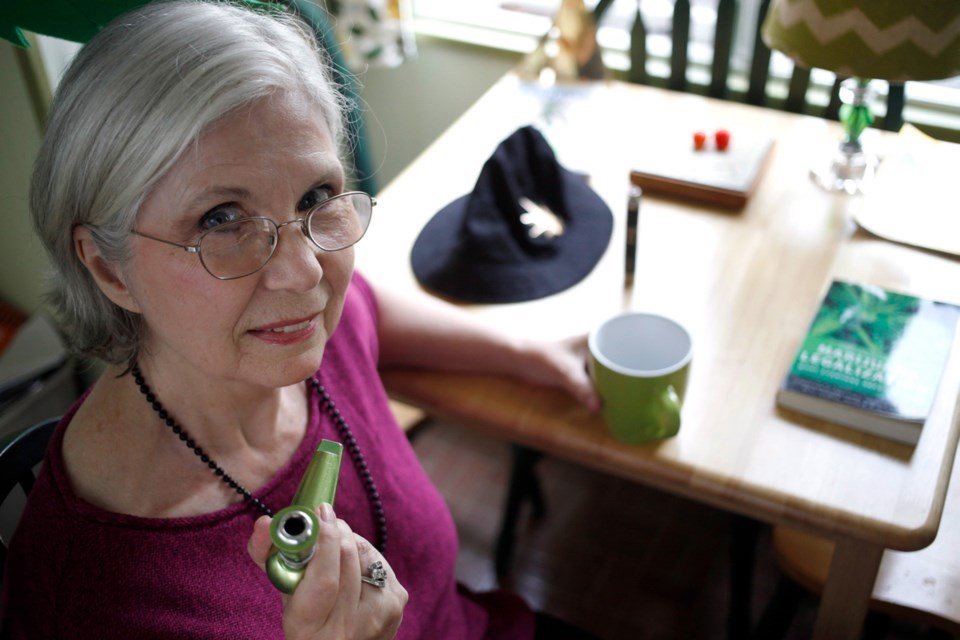TORONTO — Carol Francey waxes nostalgic when she thinks back to the first time she tried pot. The year was 1966, the place was Toronto’s hippie-packed Yorkville neighbourhood, and she was 17.
The Victoria resident has been using pot ever since, she says — 52 years. Most of that time, she did it in secret.
“I worked for the government most of my life, I was a school teacher, I was teaching elementary school,” says Francey, who now uses cannabis for recreational and medical reasons. For a long time, she even kept the secret from her son.
“I would keep it private from him until he was a teenager and then we would discuss it. But you didn’t want to put your child in any jeopardy, you were afraid that the school authorities would be really concerned about it, much more so than if you had all the alcohol in the world in your room.”
If popular culture is full of pot icons who happen to be male — think Bob Marley, Cheech and Chong, Snoop Dogg, Seth Rogen and Woody Harrelson — this is why, says cannabis advocate Irie Selkirk.
While women have long been part of the grey market using and celebrating cannabis, it’s largely been in the shadows, and under a much harsher stigma than that faced by men, says the Toronto-based speaker and consultant.
“It was incredibly accepted for generations for men to unwind with their whisky or their scotch at the end of the night,” notes Selkirk, who also works with the licensed producer Emblem Cannabis and accessories company Tokyo Smoke.
“Men are obviously given far more liberties as far as judgment goes and it’s a lot easier for a male parent to find themselves a little less stigmatized.”
Of course, attitudes have changed rapidly in recent years as a growing number of U.S. states embraced recreational use and as Canada inches toward legalization in October.
A scan of Canada’s burgeoning cannabis sector suggests women are a major focus for licensed producers eager to tap into the market, with edibles and health products, such as topicals — expected to be legal by July 2019 — seen as especially lucrative avenues.
That has opened doors for female-led and female-focused startups, as well as female influencers, entrepreneurs, growers, edible-makers and product creators — many of them chasing female customers.
Mary Beth Williamson, incoming chief marketing officer of the women-focused Fleurish Cannabis, says there are gender differences when it comes to cannabis use. Her research suggests women are especially interested in edibles and self-care products for issues including insomnia, anxiety, joint pain/arthritis, migraines and menstrual cramps.
“They’re more likely to use it with a partner or friends, whereas men may use it more often alone,” says Williamson, whose company has commissioned studies into female pot users. “Women are looking on average for a little bit lower THC levels [the psychoactive ingredient], so that they’re more in control, and women are looking more for citrus, fruity, floral-type experiences.”
But as companies such as Fleurish emphasize the health potential of cannabis, some observers are cautious about claims increasingly associated with the herb.
There’s simply a dearth of scientific data, says Dr. Jason Busse, co-director of the Centre for Medicinal Cannabis Research at McMaster University in Hamilton.
“We’ve got all these reports from individuals claiming that they think it does more than just provide that temporary euphoria,” Busse says.
“What we really need now is good research so that the authorization of this product for medical purposes doesn’t get ahead of the evidence.”
While Selkirk is buoyed by apparent economic opportunities for women, she is wary of women being reduced to “a target market” with superficial concessions that may not actually serve or support them.
“As this industry gears up there’s a lot of big money and big business and people are looking at how to cash in on it,” says Selkirk, whose initiatives include creating networking opportunities for women keen to enter the industry.
“It’s very important to me as a cannabis advocate and a patient advocate to make sure that women are a part of the conversation as it pertains to them, so that means having women in the industry as well.”
Even experienced female cannabis users need a lot more information, says Williamson, whose research suggests many don’t buy their own marijuana.
Although women tend to be the primary buyer in most households, when it comes to cannabis, most get it from a friend or a partner, she says.
“They’re less likely to know what strain they bought, they’re less likely on the most basic level to know whether they were consuming a hybrid, an indica or sativa [type of plant].”
A recent Newsweek headline deemed legal marijuana “the first billion-dollar industry not dominated by men.”
But Alison Gordon, CEO of 48North Cannabis Corp., is skeptical of such claims, insisting women are still a rarity at the executive level. The counter-culture roots of the cannabis world won’t change those traditions overnight, she says.
“The cannabis industry is almost a banking industry in so many ways, it’s a huge part because the capital required to build these businesses and see through this window of regulation and waiting for everything to be rolled out is immense,” Gordon says.



